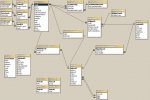benjames_au
New member
- Local time
- Today, 21:29
- Joined
- May 10, 2005
- Messages
- 5
Hi.
Im a beginner-intermediate access user (I guess) and I am working on a stakeholder management database, which essentially enables me to separate organisations, individuals, the affiliation between the two, and addresses of either individual or organisation. (pic of relationships included).
Originally, I stored address values on each respective table (ie. org address was on the org table, individual address on the individual table). However then it became apparent that one organisation (in my line of business) can have many address sites, therefore the need to nominate multiple addresses.
So I figured that the best method would be to have an address repository, and orgs or individuals are assigned to that address via a MultiAddress table. The preferred postal address would be nominated by an address preferred field in another junction table.
Seems to work ok through the form (see form pic attached), but Im concerned that when I try to run queries/reports that I'll get duplications or other anomalies.
Can anyone provide me with some tips or advice???
Cheers
Im a beginner-intermediate access user (I guess) and I am working on a stakeholder management database, which essentially enables me to separate organisations, individuals, the affiliation between the two, and addresses of either individual or organisation. (pic of relationships included).
Originally, I stored address values on each respective table (ie. org address was on the org table, individual address on the individual table). However then it became apparent that one organisation (in my line of business) can have many address sites, therefore the need to nominate multiple addresses.
So I figured that the best method would be to have an address repository, and orgs or individuals are assigned to that address via a MultiAddress table. The preferred postal address would be nominated by an address preferred field in another junction table.
Seems to work ok through the form (see form pic attached), but Im concerned that when I try to run queries/reports that I'll get duplications or other anomalies.
Can anyone provide me with some tips or advice???
Cheers


